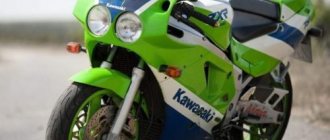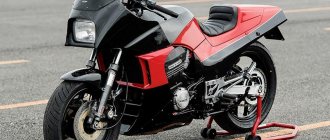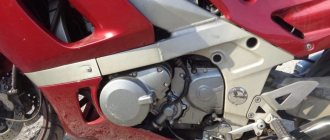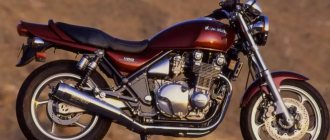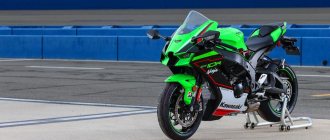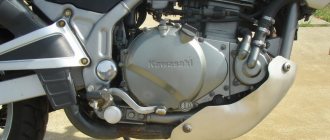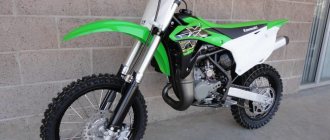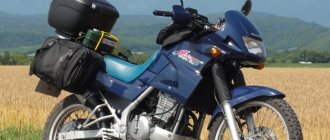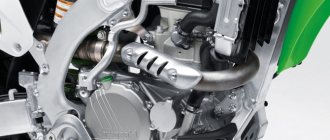- motorcycle model, Kawasaki brand
The Kawasaki GPZ 1100 sports tourer model was first presented in 1994 at an exhibition in Cologne, and official production and sales started in 1995. The model is a reincarnation of the motorcycle of the same name, produced from 1983 to 1985 (factory designation - ZX1100A), as well as a cheaper and more touring version, built on the basis of the flagship Kawasaki ZZ-R1100.
Featuring smoother engine tuning and a comfortable riding position, the Kawasaki GPZ1100 was equipped with a simple steel frame, simple suspension and 2-piston front brakes.
In 1996, the company offered a version of the Kawasaki GPZ1100 with ABS (such models were designated as ZX1100F, while the basic version was ZX1100E.)
The model was based on an in-line 4-cylinder liquid-cooled engine with a volume of 1052 cm³, producing up to 129 hp. power (for full-power European versions). The engine differs from the Kawasaki ZZ-R1100 engine in the absence of inertial boost, smaller carburetors, exhaust system and tuning for high performance at mid-range speeds.
The Kawasaki GPZ1100 was available in all major markets including North America, Europe, Australia and Japan.
1999 was the last year of production, after which the model finally left the markets and the GPZ1100 name was never used again.
Appearance
The difference in the design of the sports and sports-tourist versions is small. First of all, of course, the dimensions differ. A sportbike is shorter and not designed to be ridden by two. That is, this is physically possible, but it will be much safer for the passenger on the sports-touring Kawasaki GPZ 1100. The latter also has a container for things, which at the same time insures the rear passenger.
The car looks like a typical representative of the sports and sports-tourist classes of the end of the last century. Angular shapes, medium-height windshield, alloy wheels. Many bikes look like this model, so there is nothing unique about the appearance of the GPZ 1100.
This bike was available in silver, red and black colors. All three paint options work well for a sports tourer. However, many other colors would suit him just as well. The mirrors are moderately high, so they do not stand out in any way and serve a purely practical function.
If you compare both options from the photo, you won’t find much difference except the length and the rear seat. So if you want an old sports-class motorcycle and plan to ride it alone and not far, a sportbike is quite suitable.
Review of the Kawasaki GPZ 1100 (ZX1100E-F) motorcycle
I’ve been using this bike for the second season now (my mileage is about 30,000 km), the speedometer shows just over 50,000, and in principle I don’t notice any serious problems with it. Well, yes, the engine is NOISY (just like all CAVs) and yes, it’s HEAVY (but it’s a tourist and not a sport).
and in two years of operation it has never let me down! Its large weight is a plus, it doesn’t drift on the road, it handles like a bicycle, it’s quite reliable, it has a very comfortable seating position, it has low fuel consumption (I compare it to a blackbird (my previous bike)) and very smooth thrust from the engine,
The suspension has never been punctured, although I often ride with number two around the region and I have 120 kg
in general, whoever decides to take it for long trips will make you happy!
I’ll start with the seating position, for a tall person (195 cm) it’s simply gorgeous, it doesn’t stiffen at all, the hands don’t get tired, the passenger is also extremely happy, because the rear sofa is not suitable for sleeping or for other activities (or rather, it’s not as comfortable as on sofa). The rider doesn’t get tired even after a long ride, you don’t notice 100 km, but when riding to Taman, which is more than 270 km at an average speed of 160-200, I was the only one who wasn’t tired on my sports tour, the guys on the sports tour were exhausted. Wind protection is at a high level, so you won’t be in danger of pumping up your neck.
The engine is distinguished by excellent traction in any gear, out of 150 horsepower the device was left with 120 horsepower, making it not so sharp and sporty, the name sport-tourist must be said with greater emphasis on the tourist, because the engine is not very aggressive for a kilogram, of course, although 600s like Yamaha R6 allows you to overtake “with difficulty and not with little”. His appetite for oil and gasoline is really pure kilograms))), the average gasoline consumption per hundred fluctuates from 8 to 12 liters, you need to keep an eye on the oil, you don’t think that taking a motorcycle with a mileage of 30-50 thousand km is the first round ? For 1000 km you will have to add 100-200 grams, how to unscrew it. In fact, oil consumption is its only soreness (OR I GOT THIS), but the bike willingly feeds not only on Motul 7100. It is failure to monitor the oil that leads to frequent deaths of engines of both ZZRA and other liters: either the liners will turn, then the knee will close and etc. It's so difficult to straighten the bike and check the oil level before starting the bike. In fact, this model does not have ZZR's problems.
The transmissions are a bit short, which is not surprising for a tourist. What pleased me was the suspension - it’s soft and at the same time allows you to enter turns by touching your knee; driving over buoys and rocky roads does not cause any inconvenience. On the highway you can relax, here the bike is in its element, with soft suspension, good wind protection and with a considerable weight of 200 kg, you feel like on a steamship, there is enough gas and traction for any overtaking, it holds the road like a steam locomotive on rails. In the city you don’t feel inferior either, the bike handles great, pulls great from the very bottom, and thanks to the not too inflated body kit, squeezing between cars is quite easy.
Special words of gratitude to the mixed oil-water cooling system. Even on the hottest days, when the air temperature was over 45 degrees, in traffic jams, it did not warm up above 90 degrees. The rare switching on of the huge fan was so short-lived that suspicions about its serviceability sometimes crept in. Although it is not so easy to deploy this embrasure in the city, the bike cannot be recommended for people of short stature and puny build. One of the few kilograms that can forgive the rider his mistakes (not too big). Good brakes for such a kid. Getting a motorcycle stuck even from the clutch is a fantasy task.
True, not the whole story is so good, there were some mistakes, when the needles were covered and in the morning the mood was spoiled by the sight of the bike in a huge puddle of gasoline, but in the evening I filled in 20 liters ((. The most offensive thing happened again the next morning, when I realized that the faucet was also not working holds it, and the neighbor sarcastically joked that nowadays they wash asphalt with gasoline.
Summing up, we can say that the motorcycle is, of course, slightly outdated, and the design cannot be called modern; the high weight and small number of horses do not allow it to compete with its peers from the sports league, but also allow it not to lag far behind them. Pure sports tour as it should be.
I didn’t plan to buy this particular motorcycle, but everything happened spontaneously, as always, and so…. hop... I am the owner of GPZ. I got it in 1995. for 120 tyr two years ago, i.e. this season will be the third. The moto was in good condition. So I sat down and went. It rushes like a motorcycle with an engine capacity of 1100 cm3, produced in 1995. 147 horses are enough for me (the full-power version).
hop... I am the owner of GPZ. I got it in 1995. for 120 tyr two years ago, i.e. this season will be the third. The moto was in good condition. So I sat down and went. It rushes like a motorcycle with an engine capacity of 1100 cm3, produced in 1995. 147 horses are enough for me (the full-power version).
The speedometer is in miles, the last number is 180. The needle reached 160 and a little more. Comfortable highway speed for me is 100-130 miles. In terms of dimensions, the GPZ is narrower than the ZZR, which in my opinion is more convenient in a traffic jam, and I make my way through it every morning on the way to work from Bataysk to Rostov.
By the way, with my height (198 cm), I feel quite normal on the GPZ. The GPZ can be ridden either with a straight seat or in the “fetal position”, which is why it is a sport-tourist.
We have almost all consumables in our store, with the exception of the air filter. HUGE respect to Belka for the air filter!!!
I pour Liquimol oil, somehow it was all wrong on Motul... last year I tried to fill it with 7100 10W/40, so I drove it a little over a thousand and drained it...
The box crunches... what did you expect from Kawasaki? It crunches when switching from first to second, but all the others seem to turn on normally. Pah-pah-pah…. in two seasons on GPZ, my only plate broke ... well, you understand why.
It crunches when switching from first to second, but all the others seem to turn on normally. Pah-pah-pah…. in two seasons on GPZ, my only plate broke ... well, you understand why. But now I can solder plastic perfectly
But now I can solder plastic perfectly
I’m not going to sell the bike yet - I’m completely satisfied with it. Although, if there is someone who wants to take it from me for 200-250 thousand, I’ll think about it 
Comfort
The car starts quite quickly, which is convenient for those who know how to handle fast bikes. A good choice for motorcyclists who have already mastered road and touring motorcycles and now want to try something sporty. Such people are already ready for relatively high speeds and the heavy weight of the bike.
Due to the fact that the drive is chain, the noise level is of course noticeable. However, it cannot be said that it hurts the ears or is excessively loud. At high speeds, the noise of gear shifting, as well as the noise of the engine, will be less audible due to the wind.
The windshield provides sufficient protection from air currents, which become noticeable after accelerating to approximately 130 km/h. So for a comfortable and safe ride above this indicator, the rider should bend down. The instrumentation is easy to read, which is natural given the height of the front end of this Kawasaki motorcycle.
Dimensions and weight
This is perhaps the main difference between the two versions of the Kawasaki GPZ 1100. This to some extent affects the dynamic performance and comfort of use in certain situations. In addition, this also affects maneuverability.
Here are the dimensions of the sportbike:
- weight – 230 kg;
- seat height – 790 mm;
- tank volume – 20 l.
The dimensions of the sports tourist are as follows:
- weight – 242 kg;
- seat height – 795 mm;
- tank volume – 22 l.
In both cases, the dimensions and weight correspond to the standards of the class and allow you to fully experience its advantages.
The lighter sport option is better suited to an urban environment, and the sport tourer is a great choice for a traveling couple who loves fast bikes.
Specifications
The models are not very different in this regard, but there is a difference. And it is definitely worth taking into account, even if the other differences are not fundamental.
| Motor type | in-line, 4 stroke, 4 cylinders |
| Power | sportbike: 120 hp sport tourer: 125 hp |
| Torque | 100 Nm |
| Maximum speed | sport bike: 240 km/h sports tourer: 254 km/h |
| Acceleration to 100 | 3.4 s |
| Fuel consumption per hundred | 7.1 l |
| Drive unit | chain |
| Transmission | sport: five-speed sport-touring: six-speed |
| Frame | steel |
| Rear suspension | monoshock with progression sport: travel 109 mm sport-tourer: travel 125 mm |
| Front suspension | telescopic fork sport: 37 mm, travel 150 mm sport-tourer: 41 mm, travel 120 mm |
| Rear brakes | 1 disc, 1 piston caliper sport: 236 mm sporturist: 250 mm |
| Front brakes | 2 disks sport: 236 mm, 1-piston calipers sporturist: 300 mm, 2-piston calipers |
The technical characteristics of both motorcycles are at the same level. Even today they look the part, allowing these Kawasakis to compete successfully with modern bikes.
Kawasaki GPZ 1100
Brief review of Kawasaki GPZ 1100
The Kawasaki GPZ 1100 motorcycle was produced in the 80s and 90s of the last century, and its two generations are very, very significantly different from each other. The first, produced before 1985, is a fairly typical sports bike of those years, and the second, launched into mass production after a 10-year break, is a sports touring motorcycle. In fact, both generations of the GPZ 1100 are completely different motorcycles, and they are united only by a common name. Since the first generation is practically never found in Russia, in this article we will look at the second generation Kawasaki GPZ 1100.
This motorcycle was designed using an engine from another sports tourer - the Kawasaki ZZR 1100, and later modified versions of this engine were installed on the ZRX 1100 model. This engine has moderate characteristics, but overall good driving performance and the low price of the model on the secondary market make it The GPZ 1100 is quite popular, although it cannot boast the same popularity as the ZZR 1100. During its entire production, the motorcycle was not modernized, with the exception of the ABS system offered as an option.
Similar motorcycles:
- Kawasaki ZZR 1100
- Suzuki RF 900
- Yamaha FJ 1200
- Honda CBR 1000F
Technical characteristics of Kawasaki GPZ 1100
- Years of production: 1981-1985; 1995-1998
- Class: sport-tourist (second generation)
- Frame: tubular steel
- Engine: 4-stroke, 4-cylinder, in-line
- Engine capacity, cubic meters see: 1058
- Cooling: liquid
- Valves per cylinder: 4
- Fuel supply: 4 carburetors
- Power: 130 hp (at 9500 rpm)
- Torque: 100 Nm (at 7500 rpm)
- Maximum speed, km/h: 255
- Acceleration from 0 to 100 km/h: ~3.8 seconds
- Transmission: 6-speed
- Wheel drive: chain
- Front tire: 120/70-17
- Rear tire: 170/60-17
- Front brakes: 2 discs 300 mm, 2-piston calipers
- Rear brakes: 1 disc 250 mm, 1-piston caliper
- Front suspension: telescopic fork
- Rear suspension: Progressive monoshock with preload adjustment
- Gas tank volume, liters: 22
- Fuel consumption at 110 km/h, liters: ~7
- Dry weight, kg: 242 (version without ABS)
Pros and benefits of Kawasaki GPZ 1100
- Advanced wind protection
- Good dynamics
- Comfortable seating and comfortable standard seat
- Capacious gas tank
- Good directional stability
Pros and cons of the Kawasaki GPZ 1100
- High gas consumption
- Significant weight
- Ineffective brakes
- Many copies “eat up” oil from the engine to one degree or another.
History of changes
The sportbike has undergone the following evolution:
- In the first year of production, 1981, the B1 generation emerged.
- The B2 generation appeared in 1982, the engine was painted chrome-plated black, a new fairing was installed, and the instrument panel included liquid crystal display elements. The analogue injection system is also being changed to digital. The suspensions are getting stiffer.
- In 1983, the A1 generation was released. An anti-dive fork is added, and the rear suspension is changed to progressive.
- A2 was released in 1984. The changes are only “cosmetic”.
- 1985 was the last year of production of the sports version. This is the A3 generation. However, there were no changes here.
The sports tourist does not have a history of change as such. The motor is the same type, but different in characteristics. It is borrowed from the Kawasaki ZX-11. No changes were required here. The concept was exhausted.
Test drive KawasakiGPZ 500S
You often read correspondence on forums between beginners who are at a loss as to which bike to choose. As usual, the following mutually exclusive criteria come to the fore: the price should be no more than 4-5 “kilo bucks”, and the engine capacity should not be less than 600, better, of course, a liter!
Let’s not talk about the need to match driving skills to the capabilities of the technology. So much paper has been written about this and keyboards have been erased that it makes you feel sick. Let's assume that we are talking about a basic lack of information, and you are a conscious person, slightly lost in the wilds of the motor market. Well, my inquisitive friend, listen.
Once upon a time there was a time when “liters” were thought of as nothing more than utilitarian tractors, and all the really cool guys rode 500cc twin-cylinder bikes. Since then, a lot of water has flowed under the bridge of the Dnieper, and much has changed in the views of both manufacturers and potential buyers. First in America, and then in Europe, the “five hundred” were somehow taken and forgotten. Fortunately, there are still the Japanese with their special approach to things and adherence to traditions. It is thanks to them that the Big Four production range includes 500cc models that pleasantly surprise with their consumer qualities.
Among a fairly large cohort of classmates (the most common are the Suzuki GS500 and Honda CBF 500), the Kawasaki GPZ 500S clearly stands out. Without exaggeration, this model can be called legendary. Let's start with the fact that this is a long-lived model, because the first motorcycles appeared in dealer showrooms back in 1987! At that time, it was truly a breakthrough, especially in terms of design (just look at the rest of its contemporaries to understand what we were talking about). Without significant changes, as if not noticing the storms of technical revolutions, the motorcycle was mass-produced until 2003. We tried to find out what the secret of the longevity of the Kawasaki GPZ 500S is, using the example of a motorcycle produced in 2001.
A black-as-night Kawasaki fell into our hands thirsty for rides. Having gone through a couple of insignificant restylings during its career, the bike has decisively rolled into the new millennium, and still does not look like an anachronism on the road. It is not encased in plastic “from head to toe,” but the fairing and aerodynamic “plough” at the bottom give the bike a complete, and most importantly, quite solid look, with a touch of conservatism. The same goes for the dashboard - three different-sized analogue scales are easy to read and have a classic design. It seems that everything is as it should be, but no, this is where the first “jamb” comes out, reminiscent of the actual age of the model: the motorcycle is not equipped with a fuel level indicator, which subsequently gave us a couple of unpleasant moments. Otherwise, there are no complaints; all the buttons on the remote controls, both on the left and on the right, are intuitive and allow you not to be distracted from the road.
Sitting on a motorcycle will be a pleasant discovery for most drivers: on a moderately wide seat you can cover hundreds of kilometers. And the seat/steering wheel/pegs triangle is also good, and with a height of 176 cm, I never had to complain about the ergonomics either during country trips or in the city crowd.
The most important impression from the motorcycle, which surprised me throughout the test, was its ease of control. In the city you ride as if on a bicycle, only there is something rumbling below, reminding you that this is still a motorcycle. Maneuverability at low speeds is excellent. As the speed increased, the pleasant impressions did not become less. The motorcycle reliably holds a straight line, and good wind protection plus the ability to “lie down” on the tank will be useful in long-distance driving.
The frame is duplex, welded from square steel pipes. Considering when it was designed, the torsional rigidity indicators are a very solid four even by today's standards. This has a positive effect on handling at significant speeds (just don’t delude yourself and imagine yourself as a sportsbike driver). The frame is complemented by suspensions, which, despite their simplicity, combine the necessary rigidity for acceptable handling with energy intensity. However, you should not mock it unnecessarily, because the fork is prone to “leakage,” and the monoshock absorber here is not for enduro raids.
The GPZ 500 engine is a real unique one. It is unique in that it has been produced for God knows how many years with almost no changes. And it is also installed on 3 (!) completely diverse models: the classic ER5, the “parquet” enduro KLE 500, and the cruiser EN 500. What kind of station wagon is this that “...plays the pipe”?
So, this is a two-cylinder “in-line”, which, unlike competitors’ engines of similar design, is equipped with a liquid cooling system. The light and fairly lively power unit amazes with its simply indecent elasticity, which allows you to drive in the city in 2nd-3rd gears, as if in an “automatic”. On the highway it’s the same story, only you need to engage fifth or sixth. By the way, the gear ratios are chosen in such a way that if there were no sixth gear, no one would have noticed it. At the same time, the engine spins willingly, starting to really give out the “horses” hidden in it; after 6000 rpm, it wants and can spin, but do not overdo it. The camshaft drive and the camshafts themselves can be easily “killed” by constantly twisting the engine until it rings. Don't force the engine, and it will serve you well for many years. The gearbox has no complaints, it works very clearly and unambiguously, with reliable locking of all gears. It is worth paying attention to this unit on motorcycles manufactured before 1994: gears may “fly out”, the gearbox as a whole may not work smoothly, making unhealthy mechanical noises.
The Kawasaki GPZ 500S has proven to be a reliable and well-made machine. So smart that it lasted on the assembly line for a good 16 years, and even today it looks quite up to par. This is a strong average bike, a motorcycle with which you can be friends. And in general, everything here is like in life: you can “love” the windy beauty R1, but you “marry” the Kawasaki GPZ 500S.
Text: Denis Los
Photo: michel
